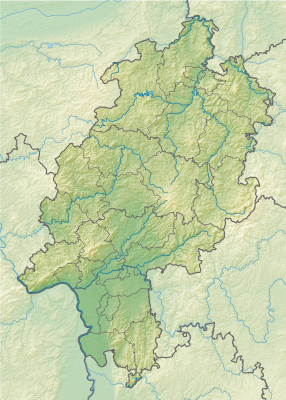Altenburg (Niedenstein)
| Altenburg | ||
|---|---|---|
|
Altenburg near Niedenstein |
||
| Alternative name (s): | Green plate | |
| Creation time : | 2nd millennium BC Chr. | |
| Castle type : | Hilltop castle | |
| Conservation status: | ruin | |
| Standing position : | To chat | |
| Place: | Niedenstein | |
| Geographical location | 51 ° 14 '51.6 " N , 9 ° 17' 26.2" E | |
| Height: | 450.7 m above sea level NHN | |
|
|
||
The Altenburg , also known as the Green Plate , is a prehistoric castle on the Altenburg mountain near Niedenstein in the Habichtswald Nature Park in the Schwalm-Eder district , northern Hesse ( Germany ).
Geographical location
The remains of the hilltop castle are on the Altenburg mountain ( 450.7 m above sea level ) between Niedenstein (Schwalm-Eder district) in the southeast and Bad Emstal- Sand ( Kassel district ) in the west. The summit region of the wooded mountain is an almost rectangular basalt plateau around 500 m long and 300 m wide.
The Eder tributary Ems runs through the valley to the west of the Altenburg, and its tributary Wiehoff to the east . On the mountain slopes in the north-west and north-east, which are not protected by natural cliffs, the castle complex was protected by stone ramparts , some of the remains of which can still be seen.
history
The settlement began in the 2nd millennium BC. BC and finally ended around AD 25. The assumption that the Altenburg could be the Chattic capital Mattium mentioned by Tacitus was refuted by research in the middle of the 20th century. Why the settlement was abandoned can no longer be clearly clarified. There is speculation that passing Suebi may have plundered and destroyed the castle complex.
Excavations
During excavations that took place between 1905 and 1913, the castle complex was extensively examined and scientifically evaluated. Protective walls, main wall, gates, culverts and clay deposits were uncovered. The stone walls were originally reinforced with wooden structures. The total length of the ramparts was about 3000 meters; the core area of the fortified hillside settlement was 15 hectares, the total area about 70 hectares. Several round depressions turned out to be wood-paneled pits and cisterns . One pit was used as a pottery mash pit .
Stone axes, knife blades and shards of ceramics, which can be assigned to the Michelsberg culture , date from the younger Stone Age . In the mash pit one found shovels, tubs, gable ornaments, door and plates and the like. a. The Altenburg was still littered with shards of clay pots and also with hearths and post holes, which suggest a densely populated settlement. The finds also include items for domestic use made of bronze, such as belt hooks, needles, horse jewelry and a door leaf made of oak.
The finds are kept in the Hessian State Museum in Kassel and described in the Niedenstein community center, where there is also a model of the historical complex. Information about the history and the excavations of the Altenburg can be obtained from boards that were installed in a refuge on the Altenburg.
Individual evidence
literature
- Ulrike Söder: The Iron Age settlement of Altenburg near Niedenstein, Schwalm-Eder-Kreis . Rahden, Westphalia, 2004 (Marburg studies on prehistory and early history, 21).
Web links
- Altenburg (Niedenstein), Schwalm-Eder district. Historical local dictionary for Hesse (as of June 30, 2014). In: Landesgeschichtliches Informationssystem Hessen (LAGIS). Hessian State Office for Historical Cultural Studies (HLGL), accessed on November 20, 2015 .




